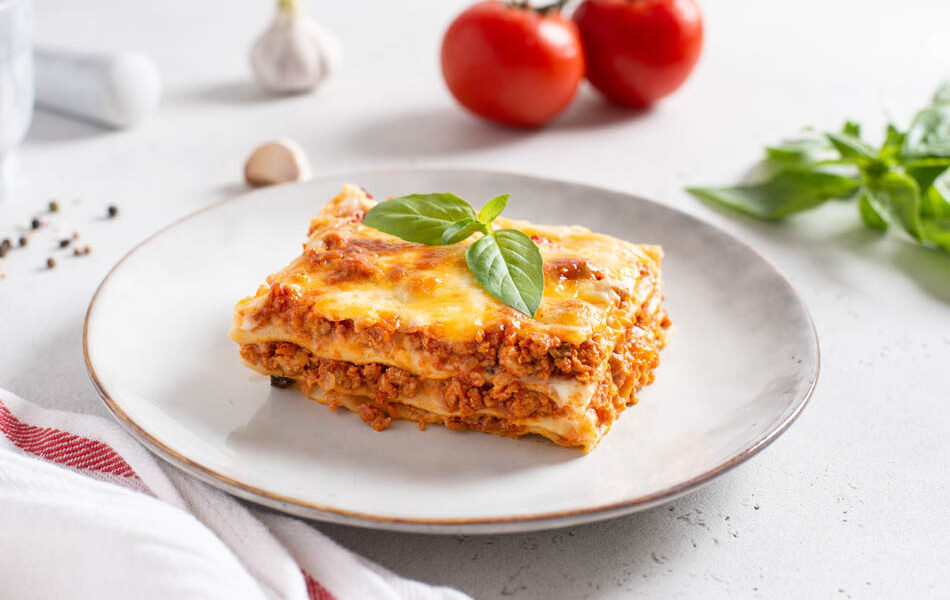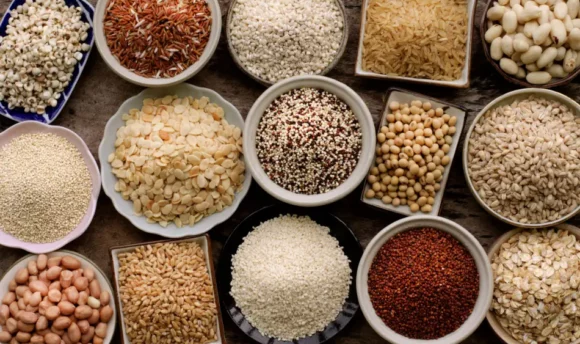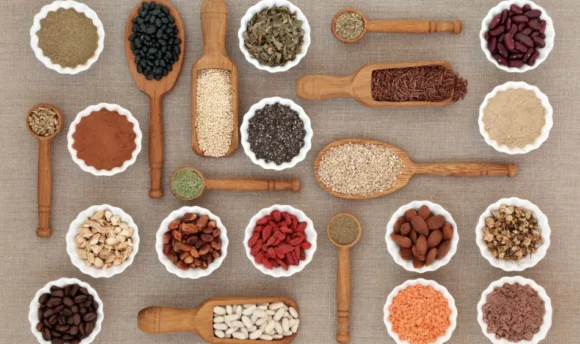Is Lasagna Healthy? Nutrition, Calories and Carbohydrates
Lasagna is a popular comfort food full of lasagna noodles, tomato sauce, ground beef, and cheese. However, is eating lasagna dangerous for your health?

We all love our lasagna recipe paired with crisp breadsticks and topped with freshly grated parmesan cheese. So it makes sense that this leads many to wonder how eating lasagna impacts their health.
From the noodles and ground beef to the cheese and side dishes, let’s talk more about lasagna’s benefits, risks, and nutritional information. Read on to learn more!
Is Lasagna Healthy?
Lasagna is not quite healthy because it is high in fat, calories, sodium, and carbohydrates. So stick with consuming lasagna in moderation and in small portion sizes.
3 Benefits of Lasagna
Besides being high in fat, sodium, net carbs, and more, lasagna does have some health benefits as well. Let’s talk about them!
#1 Excellent source of protein
One main benefit of lasagna is that it is high in protein. A 100g serving of lasagna contains almost 7.5g of protein from the cheese and the ground beef inside, according to the United States Department of Agriculture (USDA) FoodData Central database.
Most lasagna recipes contain a meat sauce that includes ground beef; however, an easy healthy lasagna recipe could include other types of meat as well or even can be vegetarian.
Protein is essential in the diet as it facilitates every chemical reaction in the body and promotes adequate growth and development.
#2 Low in dietary cholesterol
Lasagna is also low in cholesterol, which is a type of fat found in animal products. Although lasagna contains meat and cheese, a 100g serving only contains 16mg of cholesterol.
Excess cholesterol can contribute to an increased risk of heart disease.
#3 Provides calcium for strong bones and teeth
Lasagna contains cheese, which is an excellent source of calcium. A 100g serving of lasagna includes 82mg of calcium.
Calcium works together with vitamin D to support strong and healthy bones and teeth.
Lasagna Nutritional Facts
Let’s dive into more information about the nutritional facts of your typical lasagna recipe.
Nutritional table (per 100g)
| Calories/Nutrient (per 100g) | Amount |
| Calories (kcal) | 139 |
| Sodium (mg) | 390 |
| Net Carbs (g) | 16.2 |
| Fiber (g) | 1.6 |
| Sugar (g) | 3.33 |
| Fats (Total) | 4.97 |
| Protein (g) | 7.45 |
| Cholesterol (mg) | 16 |
Source: https://fdc.nal.usda.gov/fdc-app.html#/food-details/1102134/nutrients
High in carbohydrates
Based on the nutritional information above from a regular lasagna recipe with meat sauce and tomato sauce, lasagna is high in carbohydrates, with about 16g in a serving of 100g.
For reference, 100g of lasagna is about half of a regular-sized piece of 4 inches by 2.5 inches. Therefore, when you consume a regular piece of lasagna, you have about 32g of carbohydrates.
Additionally, since a 4-inch by 2.5-inch piece is relatively small, it is easy to want another piece or two. So, the carbohydrate content can just keep adding up.
Low in vitamins and minerals
Besides the tomato and any vegetables you may add, lasagna is not especially high in vitamin and mineral content.
Tomatoes contain vitamin C, which helps support a healthy immune system and promotes wound healing.
Also, vitamin C is an antioxidant that protects cells in the body from free radicals that can cause inflammation and oxidative stress.
For an easy healthy lasagna recipe, add more vegetables to your lasagna, such as carrots or spinach, to increase the vitamins and minerals of your dish.
High in fats and calories
Unfortunately, a typical lasagna recipe is high in calories and fat at 139 calories and almost 5g of fat in a 100g serving. Cheese and meat sauce likely contribute most to this food’s caloric and fat density.
Of the five grams of fat, over 2g are saturated fat, which, when eaten in excess, can contribute to an increased risk for heart disease.
In an easy healthy lasagna recipe (see below!), you can swap out the ground beef for different leaner meat!
Low in cholesterol
A pro of lasagna is that it is low in dietary cholesterol. Cholesterol is a waxy type of fat that is naturally produced in the liver.
Our livers produce enough cholesterol to keep us alive and healthy. Therefore, there is no need to consume any in the diet! However, many foods contain dietary cholesterol – mainly animal products, such as meat and cheese.
Rather than providing a specific amount as a recommendation, the 2020–2025 Dietary Guidelines for Americans recommend consuming as little dietary cholesterol as possible.
Consume as little as possible because too much cholesterol in the diet can contribute to the development of heart disease and increased risk of heart attack and stroke.
However, many healthy foods, such as low-fat dairy, lean chicken, or fish, also have a little bit of cholesterol.
So, rather than avoid foods that have cholesterol – all animal products – just opt for the ones that make the cholesterol worth it by giving you many other vitamins and minerals.
High in sodium
Another downside of lasagna is the fact that it is high in sodium. Meat and cheeses, such as parmesan or shredded mozzarella cheese, can contribute to the high salt content.
A 100g serving contains almost 400ng of sodium, which is classified as a high-salt food.
According to the American Heart Association, it is recommended to consume no more than 2,300mg of sodium per day. However, for even better health, they recommend 1,300mg as more ideal.
The International Journal of Molecular Sciences also discusses how a high sodium diet can contribute to an increased risk of heart failure, kidney or renal disease, and other comorbidities.
Now let’s dive into some healthy recipes that demonstrate some ways to make healthier substitutes when making your lasagna, including decreasing the salt content.
Healthy Lasagna Recipe
Let’s talk about how to make an easy healthy lasagna recipe at home and some healthy lasagna ingredients to make it even more nutritious!
Ingredients:
- ½ pound lean ground turkey
- ¼ cup chopped onions
- 3 cloves minced garlic
- ¼ cup sliced mushrooms
- ¼ cup fresh or frozen spinach
- 9 whole-grain lasagna noodles
- 12 ounces low-fat cottage cheese
- 1 egg
- ½ cup parmesan cheese
- 1 tsp onion powder
- 1 tsp garlic powder
- 1 tsp parsley
- 1 tsp oregano
- 1 jar low sodium or no salt added pasta sauce
Instructions:
1. Preheat your oven to 375ºF and begin by browning the lean ground turkey in a large skillet on the stovetop.
2. Next, add the chopped onions, garlic, sliced mushrooms, and spinach to bulk up the nutrition and flavor of your lasagna!
3. Boil a pot of water and cook your whole-grain pasta sheets according to the directions on their packaging. Typically, they will cook in boiling water for 8–10min.
4. When the pasta sheets are done cooking, rinse them in cold water.
5. Then, mix the low-fat cottage cheese with the egg, parmesan, and season with onion powder, garlic powder, parsley, and oregano. Cottage cheese is a tasty and low-fat alternative to ricotta cheese, most often used in lasagna.
Substitute your parmesan or mozzarella cheese for nutritional yeast for an even more nutritious swap. Nutritional yeast is a vegan cheese alternative that is rich in protein, vitamin B12, and so much more while still providing that comforting cheesy and nutty flavor.
6. After making the cottage cheese mixture, layer the noodles, jarred pasta sauce, and cheese mixture in a larger baking dish.
To decrease the sodium content of your meal, choose a tomato sauce or pasta sauce that is either “Low Sodium” or “No Salt Added” to ensure that you are not getting too much salt.
If you are willing, you can even make your own tomato sauce from tomato paste, crushed tomatoes, spices, and herbs.
7. Pop the baking dish into the oven at 375 degrees and let bake for about 45 minutes until done. Finally, top with some additional parmesan cheese or nutritional yeast, pair with some fresh Italian bread and olive oil, and enjoy your healthy lasagna!
Want to check more healthy recipes? We would recommend checking DoFasting Nutrition App. DoFasting app contains more than healthy recipes and meal suggestions, it is suitable for people who are looking to enter the intermittent fasting game.

- 5,000+ healthy recipes
- Healthy desserts
- Improved eating habits
- Calorie tracker to track daily caloric intake
- Full guidance on successful diet
FAQs
Lasagna is bad for you because of its high amount of sodium, fat, carbohydrates, and calories. Therefore, consume lasagna in moderation and in small portion sizes.
Since lasagna is high in calories, fat, and carbohydrates, it can contribute to weight gain when consumed in excess.
Lasagna is a combination food that has components in the starch group from the pasta, dairy from the cheese, protein from the meat and cheese, and fruit from the tomato sauce.
A Word From a Nutritionist
Lasagna is a comforting favorite that many love to indulge in. However, this dish should be eaten in moderation and in small portions because it is high in calories, sodium, fat, and carbohydrates.
Making simple swaps can help reduce the calories and fat and significantly improve the nutritional value of the meal.
For example, using ground Turkey instead of beef can decrease the saturated fat, and substituting whole-grain pasta noodles can boost the fiber, protein, vitamins, and minerals.
Pair with a side salad or a serving or two of vegetables to get even more nutrition and help you feel full from the dietary fiber.
Make a lasagna you enjoy eating and consume in small amounts.
Conclusion
In conclusion, lasagna is not healthy because it is high in sodium, fat, calories, and carbohydrates.
Foods high in sodium and fat can increase the risk of heart diseases, such as heart attack, stroke, and high blood pressure.
Additionally, lasagna’s calories and carbohydrates, when eaten in excessive amounts, can contribute to weight gain and obesity.
However, making homemade lasagna can help improve nutrition, especially since you can include more vegetables and decrease the added salt.

















































 Select your language:
Select your language: 








